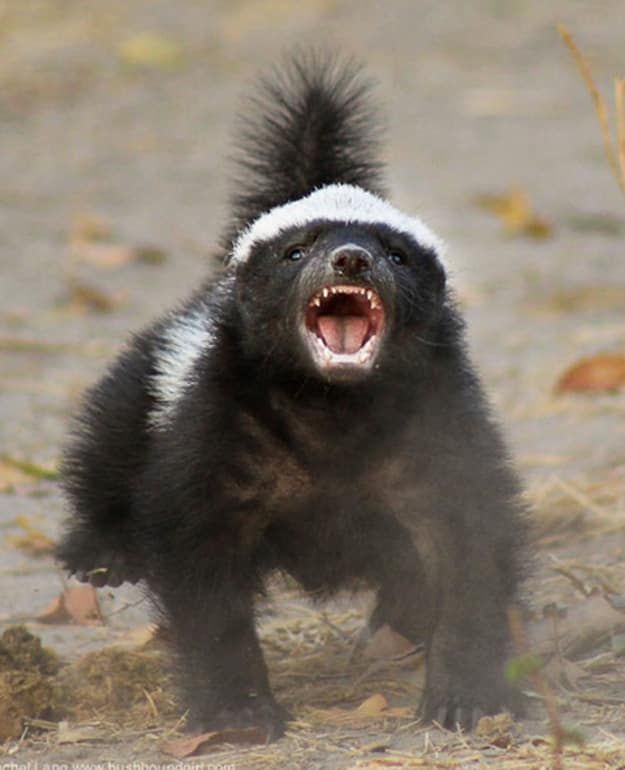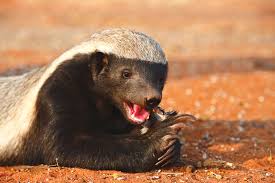The Honey Badger: Ecology, Population Dynamics, and Conservation of a Legendary Survivor
When it comes to fierce animals, size is not everything. The honey badger (Mellivora capensis) may not be the largest predator in Africa, but it has earned legendary status thanks to its fearlessness, adaptability, and sheer determination. Nicknamed “nature’s gangster,” this stocky carnivore is as much a part of African folklore as the lion or elephant. Yet behind its reputation lies a fascinating ecological story, unique population dynamics, and a conservation status that deserves attention.

Ecology of the Honey Badger
The honey badger is the sole member of its genus Mellivora and belongs to the mustelid family, which includes otters, weasels, and wolverines. Unlike many of its relatives that favor forests or wetlands, the honey badger is an ecological generalist, thriving across a wide range of habitats.
Distribution and Habitat
Honey badgers have one of the widest distributions of any African carnivore. They occur throughout sub-Saharan Africa, across the Middle East, and as far east as India. From the Kalahari Desert to moist forests and alpine grasslands, their adaptability is extraordinary. This flexibility allows them to exploit both arid and fertile environments, though they prefer open habitats like savannas and grasslands where prey is more easily accessible.
Diet and Foraging Behaviour
The honey badger’s diet is a testament to its opportunism. True to its name, it is one of the few mammals that actively seeks out honey and bee larvae, often raiding hives and enduring stings from thousands of bees. However, its menu extends far beyond sweet treats. Honey badgers are carnivorous generalists, feeding on:
- Small mammals such as rodents and hares
- Birds and their eggs
- Amphibians and reptiles, including venomous snakes
- Insects, larvae, and scorpions
- Roots, fruits, and carrion when available
This dietary breadth makes them resilient to changes in prey availability. Their sharp claws and strong forelimbs allow them to dig out burrowing animals, while their muscular jaws can crush through tough shells and bones.
Adaptations for Survival
Several unique adaptations underpin the honey badger’s fearsome reputation:
- Thick, Loose Skin: Up to 6 mm thick in places, the skin is resistant to bites, stings, and arrows. Its looseness allows the honey badger to twist and bite back even when held.
- Powerful Claws: Long, curved claws—up to 4 cm—make them skilled diggers, able to excavate burrows in minutes.
- Resistance to Venom: Honey badgers are known to survive bites from cobras and puff adders. While they may be incapacitated temporarily, they often recover within hours.
- Intelligence: In captivity, honey badgers have been observed using tools, opening locks, and climbing obstacles to escape. This problem-solving ability hints at advanced cognition rarely seen in mustelids.
Stoffel: The Escape Artist of Moholoholo
Perhaps the best-known honey badger in the world is Stoffel, a resident of the Moholoholo Wildlife Rehabilitation Centre in Hoedspruit, South Africa. Stoffel became famous for his almost comical ability to outwit his keepers. No enclosure could hold him for long—he learned how to open gates, unlock bolts, pile rocks to climb walls, and even roll logs into place to scale fences.
His escapades, often captured on film, highlight just how intelligent honey badgers are. Stoffel has become an ambassador for his species, educating visitors about the importance of conservation while proving that honey badgers are not just fearless, but also highly resourceful. Through Stoffel, countless people around the world have come to appreciate honey badgers not as pests, but as fascinating survivors worthy of protection.
Population Dynamics
Studying honey badgers in the wild is notoriously difficult. They are primarily nocturnal, solitary, and wide-ranging, making direct observation rare. However, research using camera traps, radio collars, and field surveys has shed light on their population dynamics.
Social Structure and Territoriality
Honey badgers are predominantly solitary, though temporary associations occur between mothers and cubs or during mating. Males typically hold larger home ranges than females, sometimes overlapping with several female ranges.
- Home Range Size: In resource-rich areas, a honey badger’s range may be as small as 50 km², while in arid regions it can exceed 500 km².
- Territorial Behaviour: Individuals mark territory with anal gland secretions and urine, which carry a pungent odour believed to deter rivals and predators.
Reproduction and Life Cycle
Honey badgers breed year-round, though regional peaks are observed in line with food availability. After a gestation period of six months, females give birth to one or two cubs in burrows or rock crevices.
- Cubs are born blind and helpless, opening their eyes after about a month.
- They remain dependent on the mother for up to 14 months, learning essential foraging and survival skills.
- This extended parental care results in a low reproductive rate compared to many carnivores.
Mortality among cubs can be high, especially due to predation by large carnivores like lions, leopards, and hyenas. However, adults face few natural threats, thanks to their ferocity and defensive adaptations.
Population Trends
Reliable estimates of global honey badger numbers are lacking, but evidence suggests local declines in areas with intense human activity. Populations are thought to be stable within large protected reserves, but in agricultural landscapes, they face significant pressures.
Conservation Status
The honey badger is currently listed as Least Concern on the IUCN Red List. Its wide distribution and adaptability justify this classification. However, this status can be misleading, as it masks severe localised declines.
Key Threats
- Human-Wildlife Conflict: Beekeepers and farmers often view honey badgers as pests. They damage hives and kill poultry, leading to persecution through shooting, trapping, or poisoning.
- Habitat Loss: Agricultural expansion, deforestation, and urbanisation fragment habitats, isolating populations and reducing prey availability.
- Road Mortality: Honey badgers often scavenge on roadsides and are frequently killed by vehicles.
- Traditional Uses: In some regions, honey badger skins and body parts are used in traditional medicine or clothing.
Conservation Efforts
- Protected Areas: National parks and reserves such as Kruger, Serengeti, and Etosha provide refuges where honey badgers face less persecution.
- Conflict Mitigation: Reinforced “honey badger-proof” beehives are being promoted to reduce clashes with beekeepers. These designs protect hives from raids while ensuring farmers do not resort to lethal measures.
- Awareness Campaigns: Documentaries and media portrayals, especially those featuring Stoffel, have bolstered the honey badger’s reputation, transforming it from a nuisance animal into a celebrated symbol of toughness.
- Research and Monitoring: Continued use of camera traps and telemetry is essential to fill knowledge gaps on honey badger population sizes and movement patterns.
The Symbol of Resilience
Few animals inspire awe and humour in equal measure like the honey badger. Its reputation for fearlessness is not exaggerated—it has been seen fighting lions, raiding beehives under a storm of stings, and surviving venomous snake bites. But beyond the legend lies a complex and ecologically vital species, finely adapted to life in some of the world’s harshest environments.
The honey badger’s survival, however, is not guaranteed. Human encroachment, conflict, and environmental change all present challenges. By promoting coexistence and safeguarding habitats, conservationists aim to ensure that this remarkable animal continues to thrive.
Ultimately, the honey badger is more than just a fearless fighter—it is a guardian of ecological balance, a symbol of resilience, and thanks to Stoffel, a global ambassador for the wit and willpower of wildlife. Protecting it means protecting the integrity of Africa’s wild landscapes for generations to come.

